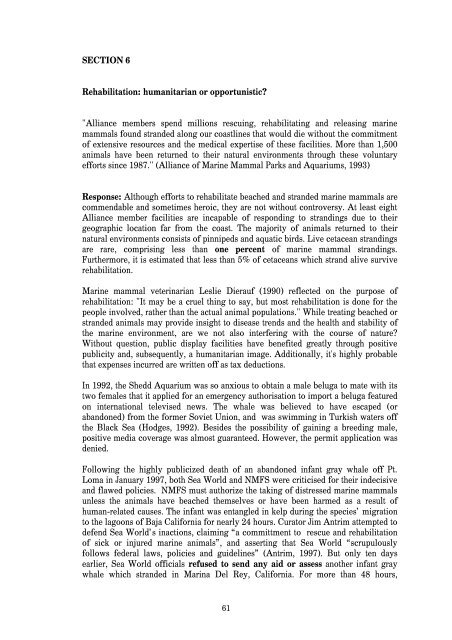Captive Cetaceans: A Handbook for Campaigners - Whale and ...
Captive Cetaceans: A Handbook for Campaigners - Whale and ...
Captive Cetaceans: A Handbook for Campaigners - Whale and ...
Create successful ePaper yourself
Turn your PDF publications into a flip-book with our unique Google optimized e-Paper software.
SECTION 6<br />
Rehabilitation: humanitarian or opportunistic?<br />
"Alliance members spend millions rescuing, rehabilitating <strong>and</strong> releasing marine<br />
mammals found str<strong>and</strong>ed along our coastlines that would die without the commitment<br />
of extensive resources <strong>and</strong> the medical expertise of these facilities. More than 1,500<br />
animals have been returned to their natural environments through these voluntary<br />
ef<strong>for</strong>ts since 1987." (Alliance of Marine Mammal Parks <strong>and</strong> Aquariums, 1993)<br />
Response: Although ef<strong>for</strong>ts to rehabilitate beached <strong>and</strong> str<strong>and</strong>ed marine mammals are<br />
commendable <strong>and</strong> sometimes heroic, they are not without controversy. At least eight<br />
Alliance member facilities are incapable of responding to str<strong>and</strong>ings due to their<br />
geographic location far from the coast. The majority of animals returned to their<br />
natural environments consists of pinnipeds <strong>and</strong> aquatic birds. Live cetacean str<strong>and</strong>ings<br />
are rare, comprising less than one percent of marine mammal str<strong>and</strong>ings.<br />
Furthermore, it is estimated that less than 5% of cetaceans which str<strong>and</strong> alive survive<br />
rehabilitation.<br />
Marine mammal veterinarian Leslie Dierauf (1990) reflected on the purpose of<br />
rehabilitation: "It may be a cruel thing to say, but most rehabilitation is done <strong>for</strong> the<br />
people involved, rather than the actual animal populations." While treating beached or<br />
str<strong>and</strong>ed animals may provide insight to disease trends <strong>and</strong> the health <strong>and</strong> stability of<br />
the marine environment, are we not also interfering with the course of nature?<br />
Without question, public display facilities have benefited greatly through positive<br />
publicity <strong>and</strong>, subsequently, a humanitarian image. Additionally, it's highly probable<br />
that expenses incurred are written off as tax deductions.<br />
In 1992, the Shedd Aquarium was so anxious to obtain a male beluga to mate with its<br />
two females that it applied <strong>for</strong> an emergency authorisation to import a beluga featured<br />
on international televised news. The whale was believed to have escaped (or<br />
ab<strong>and</strong>oned) from the <strong>for</strong>mer Soviet Union, <strong>and</strong> was swimming in Turkish waters off<br />
the Black Sea (Hodges, 1992). Besides the possibility of gaining a breeding male,<br />
positive media coverage was almost guaranteed. However, the permit application was<br />
denied.<br />
Following the highly publicized death of an ab<strong>and</strong>oned infant gray whale off Pt.<br />
Loma in January 1997, both Sea World <strong>and</strong> NMFS were criticised <strong>for</strong> their indecisive<br />
<strong>and</strong> flawed policies. NMFS must authorize the taking of distressed marine mammals<br />
unless the animals have beached themselves or have been harmed as a result of<br />
human-related causes. The infant was entangled in kelp during the species’ migration<br />
to the lagoons of Baja Cali<strong>for</strong>nia <strong>for</strong> nearly 24 hours. Curator Jim Antrim attempted to<br />
defend Sea World’s inactions, claiming “a committment to rescue <strong>and</strong> rehabilitation<br />
of sick or injured marine animals”, <strong>and</strong> asserting that Sea World “scrupulously<br />
follows federal laws, policies <strong>and</strong> guidelines” (Antrim, 1997). But only ten days<br />
earlier, Sea World officials refused to send any aid or assess another infant gray<br />
whale which str<strong>and</strong>ed in Marina Del Rey, Cali<strong>for</strong>nia. For more than 48 hours,<br />
61

















